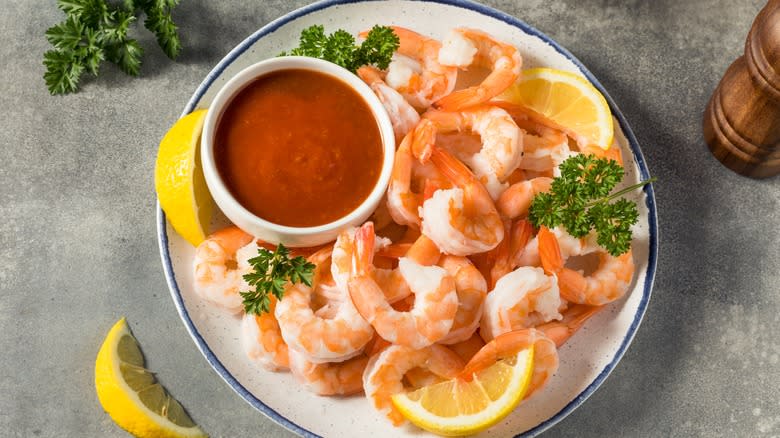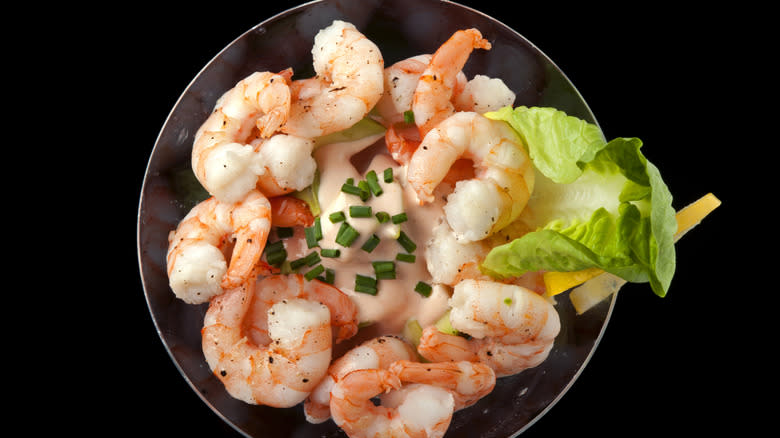The Ice Bath Technique For Perfectly Poached Shrimp Every Time

Simple and succulent, a platter of poached shrimp is the quintessential appetizer if you're looking to gussy up your next dinner party or soirée. While you can easily find a pre-made tray of the stuff at the seafood counter at your local supermarket, making it from scratch ensures the final product is fresh, properly cooked, and chilled to perfection. However, while it may seem like a straightforward dish, that's not always the case.
There are a lot of details that separate a great poached shrimp from a mediocre one. For example, what type of shrimp do you use? Frozen, fresh, jumbo, shelled, cleaned? And then there's the poaching liquid. Do you go with water and lemon juice or an ensemble of tarragon, sugar, thyme, and white wine?
But no matter the type of crustacean or the poaching liquid you use, your shrimp cocktail can abruptly end in disaster if you overcook your protein. An ice bath helps ensure it is properly cooked and perfectly plump, but to keep your shellfish from becoming dull and watery, you've got to place your shrimp in a resealable plastic bag.
Read more: 12 Underrated Types Of Fish You Should Try At Least Once
The Secret To Plump, Properly-Cooked Shrimp

First, you have to consider which type of shrimp you're using. Fresh or frozen are both fine, but in terms of size, you'll want to go with either jumbo (21 to 25 shrimp per pound), colossal (16 to 20), or super colossal (13 to 15). Then there's the poaching liquid. Lemon, salt, and pepper are a fairly neutral combination, but you can opt for something more elaborate by adding aromatics, like onion, fennel, celery, leeks, and fresh herbs.
Poaching this type of seafood is a straightforward process. Boil your poaching liquid and remove it from the heat for eight to 10 minutes. Then add your shrimp and let sit until they look pink and opaque around four to five minutes. They should feel plump, firm, and not squishy. Now here comes the important part — the ice bath.
Use a slotted spoon to remove the shrimp from the poaching liquid and place them into a resealable bag. Submerge it into the ice bath and jostle the crustaceans around with your fingers to help accelerate the cooling time. Using a plastic bag helps the shrimp avoid contact with the water, which preserves their flavor and texture. Lastly, remove them and start to peel, leaving the tails on if you're serving a shrimp cocktail.
Using Your Poached Shrimp

Yes, most poached shrimp end up circling a dish of cocktail sauce, but this succulent shellfish can be paired with more than just ketchup, lemon, and horseradish. For a refreshing warm-weather appetizer, go with a shrimp, avocado, cilantro, and lime salad. This dish brings a lot of zing to the dining table and is excellent served alongside a heavier main course.
Shrimp pasta salad is another option. Dice them up or serve whole if small enough and mix them into cooked pasta and chopped veggies. You can also go in a Mediterranean direction, like this recipe for Greek orzo salad with shrimp. But if you're not looking to add the meat to pasta, try putting them in a salad, wrap, or sandwich.
If you want to serve your shrimp in a classic cocktail style with a twist, it's always a good idea to experiment with some alternative dipping sauces. Thousand Island dressing offers some extra punch to the subtle shrimp, while a homemade tartare sauce brings some tang and herby freshness to the party. For something totally out of the box, you can go with a Thai sweet chile sauce or a big, bold Cajun-inspired remoulade.
Ultimately, whatever you decide to pair with your perfectly poached shrimp, you can't really go wrong.
Read the original article on Daily Meal.

